| National Parks | The Sea | Activities | Art and Culture | Towns and Cities | Food & Drink | Climate |
| News | Contact | Holiday Accommodation |
Art and Culture in Abruzzo
Did you know that the name ITALIA ('Italy') originated in Abruzzo in 90 BC? And that Abruzzo is the second Italian region with the largest number of well-preserved castles? All this and more you'll get to know in the following presentation as we go into detail on the highlights of the region.
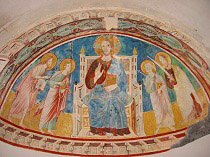
|
Please click on the respective sub-headings: The Beginnings, Pre-Roman Times, Roman Times, Medieval Times, The Renaissance, The 17th to 19th Century, Modern Times, Arts and Crafts, Literature, Archeological Sites, The most important museums at a glance
| The Beginnings |  |
Findings in the province of Chieti testify that Abruzzo has been settled without interruption for 300,000 years. At the beginning of this time man was still a hunter. Only many years later the first gatherers made an appearance. In the Grotta della Punta remains of the Homo Marsicanus, who lived here about 13,000 years ago, have been found.
| Pre-Roman Times |  |
In Abruzzo the pre-Roman, or so-called "ITALIC" time, is of very special interest to archaeologists, as the region has not yet been fully explored and so still has surprises in store. Unlike Etruscan history to give an example, the exploration of the history of Abruzzo up to the time of the Roman domination is still at an early stage. This period still holds a lot of mystery.
In 1934 a statue (2m high) of a warrior was found in Capestrano. The "Guerriero di Capestrano" dates from the 6th century BC and is the best preserved example of Italian civilisation in Abruzzo. The sculpture is the symbol of the region and can be admired today in the National Archaeological Museum in Chieti.
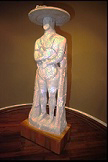 |
| Roman Times |  |
In spite of an army of 100,000 men, the Italics had to surrender to the Roman superiority. As early as the 3rd century, the Romans founded some settlements in the region of Abruzzo: Alba Fucens (Albe), Hatria (Altri), Amiternum (San Vittorino). The Romans secured their passage to the Adriatic Sea by building the Via Valeria. Romanisation took place. Today Roman civilization can be traced back to towns like Chieti with its theaters and amphitheaters.
In the year 43 BC, Ovid was born in Sulmona. He was the greatest poet of the Augustinian time, and remained attached to his town of origin even when he was obliged to live in exile at the Black Sea until his death in 17 AC. Ovid achieved his fame and reputation with his love poem "Ars Amatoria" (Art of Love). This was the only antique poem to be banned by a pope. 25 years later, Ovid wrote the "Metamorphoses", one of the most important works of ancient times.
| Medieval Times |  |
After the decline of the Roman empire Abruzzo was christianised at a very early date. Christianity essentially shaped the profile of the region. Unfortunately, much evidence of the early Christian period has been lost, only the catacombs under the church San Michele in San Vitorino and the San Giusta Bazzano take us back to that time. From the Romanesque period, however, a number of architectural and pictorial masterpieces from early Christian culture are still present today.
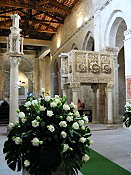
|
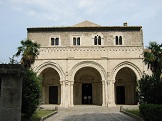
|
The Romanic Period was the golden era of Abruzzo: The sanctuaries of San Giovanni in Venere at Fossacesia, the church of Maria d’Arabona and Santa Maria Assunta di Bominaco were constructed.
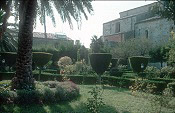
|
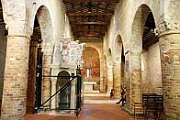
|
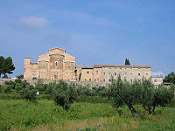
|
The pulpit dating from 1159 in the church of Santa Maria del Lago is a masterpiece of the art of sculpture.
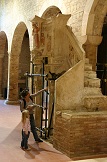
|
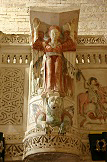
|
Between the 10th and the 13th century, Abruzzo became the favoured refuge of the monks who withdrew to the mountains to lead a solitary and spiritual life based on the model of the oriental Ascetics. The mountains of Maiella have always transmitted spirituality and represented an ideal retreat. Hermitages developed. One of the most beautiful ones is San Giovanni all'Orfento. Other hermitages worth seeing are San Bartolomeo di Legio, that recalls the pueblos in New Mexico, and Santo Spirito in Maiella.
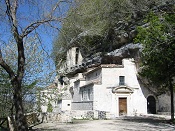
|
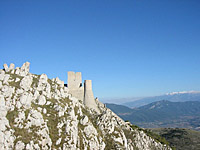
|
The horizontal scheme in the decoration of church facades is a typical symbol of the style used in Abruzzo during the Romanic and Gothic periods. A gorgeous example is the geometric red-and- white patterned facade of the Basilica di Collemaggio at L'Aquila. Other churches in the capital of Abruzzo also have this characteristic decoration. Gothic-style architecture is not very widespread in Italy. The cathedral of Atri in Abruzzo, one of the most striking and important examples of the sacral-style architecture of Abruzzo, has the typical characteristics of the new French style.
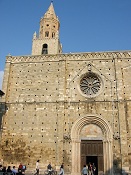
|
Fresco cycles from the period of the Middle Ages can be found in the church of S. Maria ad Cryptas and in the oratory of San Pellegrino at Bominaco. This cycle is without doubt the most significant example from the medieval times to be found in Abruzzo.
| Renaissance |  |
During the 15th century the church of Santa Maria in Piano L. Aprutino was designed in accordance with the new Renaissance style from Tuscany. In Abruzzo the cathedral of Atri houses the largest fresco cycle, with regard to size, of this period. The artist Delitio created his masterpiece here. Delitio distinguishes himself by his extraordinary imagination and subtlety as well as a special artistic sophistication and he holds his rank with his Florentine colleagues.
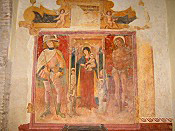
|
There are numerous buildings from the Renaissance period. Especially worth mentioning is the Palazzo Annunziata in Sulmona. The palace was constructed over the years in different styles. Overall, four construction phases of the facade can be identified.
| 17th to 19th century |  |
The language of the baroque style can be admired inside the church of San Bernardino at Aquila. An example of the neoclassical style, with its clear rhythm, can be seen in the church of Santa Maria del Ponte in Lanciano. The Baroque period was also the heyday of ceramic art. One important representative of the school of the 19th century was Francesco Paolo Michetti (1851- 1929), who gained national recognition representing rural scenes and religious themes with great passion.The MUMI Museum in Francavilla al Mare has been dedicated to this painter.
| Modern Times |  |
In Europe, the 19th century ended with Art Nouveau, known as "liberty style" or "Modernismo" in Italy. This modern style gained currency in Abruzzo too, especially in the cities and on the coast: Pescana, Giulianova, Francavilla and Ortona offer well preserved examples of Art Nouveau architecture and painting and invite inspection.
In the 20th century, during the 60's, Abruzzo became interesting for the German conceptual artist Joseph Beuys. This master directed a project called "Difesa della natura" (Defense of Nature) in the village of Bolognano. Beuys spent most of his last creative years in Abruzzo and decisively shaped the cultural landscapes in Bolognano. This village is an open studio today, offering the possibility to various young, but also to already well-known, artists to develop their creativity.
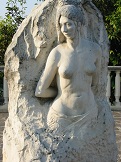
|
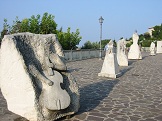
|
The "Museo dell'Arte e dello Splendore" at Giulianova is exclusively dedicated to modern art.
Enthusiasts and collectors of modern ceramic art are advised to visit the Museum in Castelli, where
the work of young ceramic artists is regularly exhibited.
The village of Scanno holds a special place in the art of photography. This small place
with its picturesque alleyways has been recorded by important photographers, for example, Henri
Cartier Bresson.
| Arts and Crafts |  |
Arts and Crafts in Abruzzo have a very long tradition up to the present day. Castelli, a
spectacularly situated "borgo" (village) at the foot of the mountains is the main centre of
ceramic production. The Baroque Era was the heyday of ceramic arts in Castelli. It's style is clearly
defined: The Madonna, landscapes and still lifes are painted on a white background in vibrant colours like yellow, azure and purple.
Nearby Castelli is the small church of San Donato, whose vault was decorated with 800 ceramics
(the so-called “Piastrelle”) in 1647.
The Italian author Carlo Levi called it the "Sistine Chapel of Maiolica".
The art of the goldsmith is still a living tradition today in Scanno and Pescocostanzo. Moreover, at Guardiagrele the traditions of "rame" (copper) and "ferro battuto" (wrought-iron) is still being practiced. A typical woman's handicraft in this area is the making of bobbin lace.
| Literature |  |
Two important figures from Abruzzo shaped modern Italian literature:
Ignazio Silone (1900-1978) who is considered one of the most important Italian authors of the 20th
century.
Many of his works (among which "Fontamara") realistically describe the hard life of the farmers
of this, before and after the war. You can find more information about this author from Abruzzo in
the "Centro Studi Ignazio Silone" in Pescina, Silone's birthplace.
Gabriele D’Annunzio (1863 – 1938), a poet born in Pescara, was part of the Italian Symbolist and
Aestetic movement. His poetry was inspired by beauty and the sensory world.
D'Annunzio can be compared with other of the European "Aestetics" figures like, for example,
Oscar Wilde. If you want to know more about D'Annunzio you can visit the house where he was
born in Pescara.
| Archeological Sites |  |
There are several archeological sites in Abruzzo:
Alba Fucens/Massa D'Albe. This old Roman town named Alba Fucens is famous for its Roman Amphitheatre, the best-preserved example in the area.
Campo Valano, Juvanum, Ocriticum, Peltuinum and Schiavi D'Abruzzo
| The most important museums at a glance |  |
| "Art Links" |
| Museo Archeologico Nazionale, Chieti | (Archeological National Museum), Navigation also in English |
| Museo Nazionale d'Abruzzo | L'Aquila |
Museo archeologico La civitella |
Archeological Museum, Chieti Also for children |
| Museo dell'Abruzzo bizantino e alto medioevale | Crecchio (Museum for byzantine art of Abruzzo) |
| Museo dello Splendore | Giulianova (Modern and Contemporary art) |
| Museo delle Genti d'Abruzzo | Pescara (Museum of Abruzzo people) |
| Museo Acerbo | (Ceramic Museum), Loreto Aprutino |
© lupus-italicus
© (Photo)